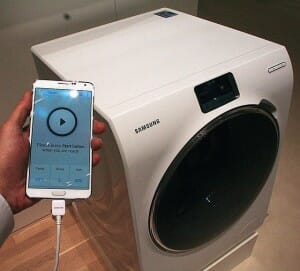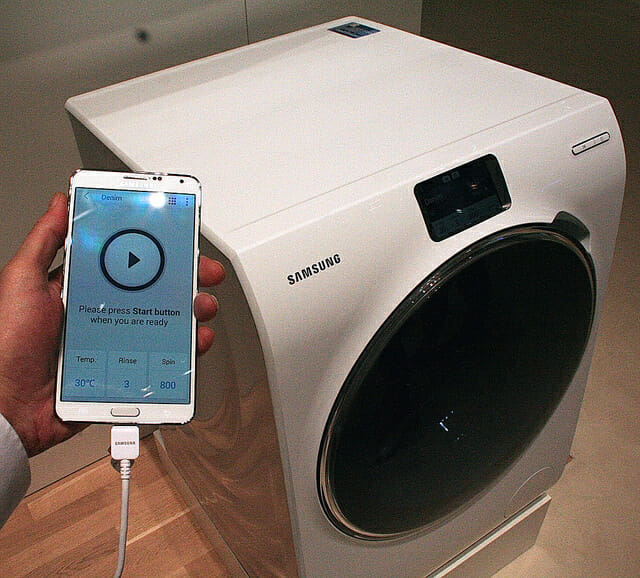This is the first article in a series about how “smart home” (or “connected home”) technology is poised to bring a whole new world of convenience to homeowners and tenants.

The folks at Zillow are on top of their game year-round when it comes to data-driven insights about the residential rental and real estate markets. And in January, there’s Zillow’s predictions of hotness for the new year.
The most intriguing prediction by Nancy Robbers is that 2015 will be the year of the connected home, or “smarthome.” She says, “Manufacturers will finally get on board with the Internet of Things and enable Internet connectivity among more devices inside a home.”
The Internet of Things is comprised of devices and appliances with on-board sensors that connect them to smartphones, computers, the Internet, and each other.
It means that with a few swipes of the smartphone, homeowners and apartment dwellers can do everything from brew an espresso and monitor pets to get alerts from the fridge when it’s running low on eggs.
In other words, convenience. With a capital “C.”
Connected home tech comes into its own
We’ve been hearing about smart homes for years, in science fiction novels and TV shows like the ‘60s cartoon the “The Jetsons,” with its futuristic vision of automated dog walkers and housekeeping robots. (For the record, the Jetsons’ robotic domestic is named “Rosie.”)
Over the last few decades, manufacturers have made progress in making the connected home a reality by producing automatic garage-door openers, baby monitors, and robot vacuum cleaners. Lately, the drumbeat has grown much louder as smart home devices, networks, and apps have become more sophisticated, and as giants like Google and Apple have tossed their hats into the ring.
Widespread awareness of the Internet of Things arrived in January 2014, when Google ponied up a whopping $3.2 billion for Nest, a company that makes “smart thermostats.” Nest thermostats learn occupants’ daily habits, like waking up in the morning, going to the gym, and coming home from work, and adjust the heat or air conditioning accordingly.
For property managers and landlords looking to attract tenants who are gadget-hungry, convenience-minded — and presumably willing to pay premium rent — converting units into smart homes may seem like a no-brainer.
It’s a thrill to see decades-old predictions come true and household standbys like toasters, microwaves, and doorbells come to life. But it’s another thing to figure out if connected home upgrades make sense for your business.
Is 2015 the right time to invest in smart home devices for your units?
Pro #1: More connected home devices are showing real utility
Another great thing about January is the Consumer Electronics Show (CES), the mammoth manufacturers’ showcase held annually in Las Vegas. At CES 2015, electronics companies unveiled thousands of futuristic gadgets that set tech junkies buzzing, and in the days leading up to the show, journalists weighing in with their favorites.
Aaron Soupporiss of engadget.com reported that most new wares on display at CES “…were off-the-shelf products you could buy and install in your apartment right now.” His top picks include:
- Parrot Pot — It’s Flower Power soil sensor technology reminds users to water their plants and keeps them alive when they forget.
- MisFit Bolt — This smart lightbulb saves energy, makes it look like a home is inhabited when it’s not, and adjusts colors in response to occupants’ sleep cycles.
- WattUp — Homeowners can charge any electronic gadget in the room within a 15-foot radius using a smartphone app.
In his column “INNOVATION ECONOMY,” tech journalist Scott Kirsner reports that more and more startups are focusing on smart home products, and many are backed by gadget fanatics on fundraising websites like Kickstarter.
Kirsner predicts that as connected electronics become increasingly more useful, instead of just novel (the Egg Minder) or entertaining (wireless audio and video systems), consumer demand will really catch fire.
On Kirsner’s list are a few products that improve home security and peace of mind, including:
- Kwikset Kevo — With this keyless deadbolt and smartphone app, users can give digital house keys to family members, the cleaning service, and the dog walker.
- SkyBell — This electronic doorbells features motion sensors that signal when someone is at the front door and lets the occupant see who it is.
- Water Hero — This system alerts homeowners when a pipe leaks or bursts so they can fix the problem before it becomes a disaster.
Pro #2: Smart home networking options mean more choice, more convenience
In addition to the utility they deliver, these newer devices connect to the Internet, usually via an inexpensive (less than $100) WiFi hub. Internet connectivity lets consumers control the devices from almost anywhere using smartphone apps. (Some devices also connect to smartphones via Bluetooth, which is handy when occupants are at home.)
Most smartphone owners use each of their apps for a particular purpose (think Google Maps, Kindle reading app, or Spotify). Extending this analogy to a home full of smart gadgets and appliances, the number of different apps and hubs a consumer would need to control everything quickly becomes overwhelming.
For example, imagine launching one iPhone or Android app to warm up the bed, another to lock the front door, yet another to start the sprinkler system, and so on. And if each of these home devices needs its own hub, expect the home to be crawling with wires, cables, and power strips. All these devices and hubs can make troubleshooting a bear, too.
The ultimate in convenience, though, is what the connected home is all about, so manufacturers and retailers are working together to cut down the number of apps and hubs needed to control smart home devices. Their solution: developing communications standards that enable products from different manufacturers to talk with each other over a common network.
Today there are plenty of operating systems, networks, and hubs to choose from, many made by one or more big industry players:
- Staples — The office mega-store told Kirsner that its $79 Connect hub links 150 devices from a range of manufacturers to a single network. Some of the things users can control are the Nest thermostat and light bulbs and door locks from numerous companies. To easily find out which devices work with Connect, all a consumer needs is a single app from Staples.
- WeMo from Belkin — According to tech blog VentureBeat, the WeMo connected home system can control 25 devices made by the likes of Mr. Coffee and Crock-Pot. At CES, Belkin introduced its communications standard, Zigbee, which connects the latest smart devices, including “key fobs, light bulbs, door sensors…”
- HomeKit from Apple — USA TODAY reported that HomeKit “lets iOS customers securely control locks, lights, video cameras, doors, thermostats, plugs and switches with their iPhones.”
- Wink from Quirky — Quirky has taken huge strides by partnering with GE and The Home Depot. Great company to have.
In addition to these familiar names and Google, companies like Motorola, Qualcomm, and Samsung have entered the game. The field is ultra-competitive and growing more crowded by the day. With so many options, which connected home platform should homeowners and property managers invest in — and how will the decision stand up over the long haul?
The next article in this series will look at arguments against investing in connected home technologies in 2015.
Read more on Maintenance

